The Akatsuki-class destroyers (Akatsukigata kuchikukan) were four destroyers of the Imperial Japanese Navy (IJN) built between 1926 and 1933. They were dubbed the Group III of the Fubuki class (24, comprising themselves) which for some authors were described as the world’s first modern destroyer. These “special type” were post-Washington treaty designs to play with the limits imposed on destroyers. Most authors regards the Akakstuki was a sub-class of the Fubuki class, in regard of the recent revealations on the improvements made on the Group III which remained secret. They were never designated officiall as a separate class and they shared technically everythunbg with the other Fubukis. The main different was in speed. They had been designed with a better powerplant to sustain 39 knots and accompany a new generation of heavy cruisers. Only Hibiki survived WW2.
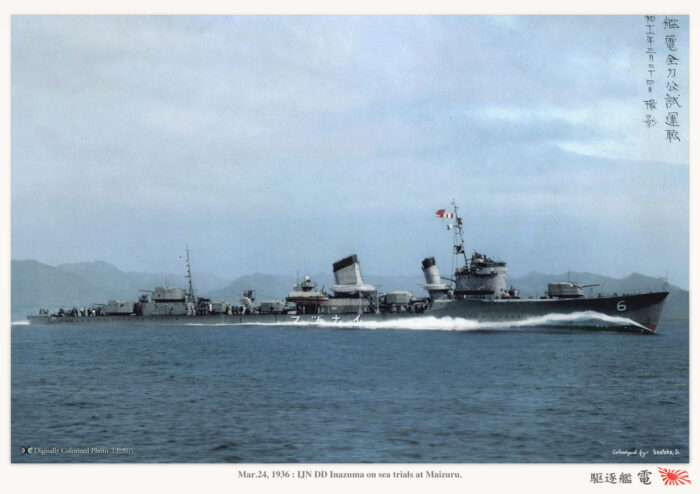
IJN Inazuma in post-overhaul trials in March 24, 1936, colorized by Irootoko JR.
Development
Differences with he regular Fubuki Group I-II
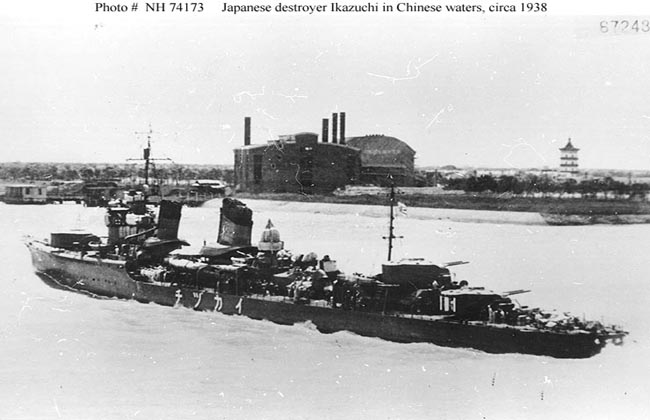
ONI recoignition photo of Akatsuki in China
After a couple of years of operational experience with the Fubuki class, the IJN General Staff issued requirements. They concerned four additional “Special Type” (Tokugata) provided with a better top speed of 39 knots (72 km/h) versus 38, and a better range of 4,000 nautical miles (7,400 km) at 14 knots (26 km/h) and to be armed with the new Type 8 torpedoes. They were designated escorts for the new powerful cruisers under consideration to continue in the path of reaching a qualitative edge, that were eventually built from 1931 to 1933 and better known as the Takao class heavy cruisers. Completed at the time of the London treaty which capped the number of 8-in armed cruisers, they were the last of a formidable serie of four 1st-class heavy cruisers, the Nachi and Takao class.
Of couse since only four of these would not constitute a substantial escort, more were ordered, ten in fact, before the order was cancelled for a new serie. Indeed it happened that more experience with the Fubuki (which the Akatstuki were based on) led the naval staff to look for a better model altogether. In parrallel were built the Hatsuharu class, a somewhat more “austere” variant. These six destroyers (1931-35) took in account the new limitations of the 1930 naval treaty imposing 260 tonnes lighter destroyers. The true replacement were the Shiratsuyu class which tried to solve the “top heavy” issues of both the Fubuki and Hatsuharu. The best compromise was found with the Asashio class, which led to the wartime Kagero class, certainly the pinnacle of IJN destroyer development, as far as serial construction is concerned.
The main difference in design between the Akatsuki and standard Fubuki-class resided in the choice of new high-pressure boiler enabling a reduction from four to just three boilers, without reduction in power. Externally this means the fore smokestack was now narrower and this became an easy visual recognition feature. The bridge was also improved, made larger, with the addition of another level for improved fire control facilities. There was also now a splinter-proof torpedo launcher/turret for the also new torpedo tubes of the Type 8. This enabled these tubes to be reloaded while in action, which could be potentially a game changer, knowing the quality and range of these new Japanese torpedoes, providing a naval action was long enough. The space freed by the missing boiler was exploited to add fuel bunkerage and many weight-saving measures were also taken. Among other, one of the class, Hibiki was the prototype all-welded Japanese ship. This saved a lot of weight and was applied gradually to latter classes.
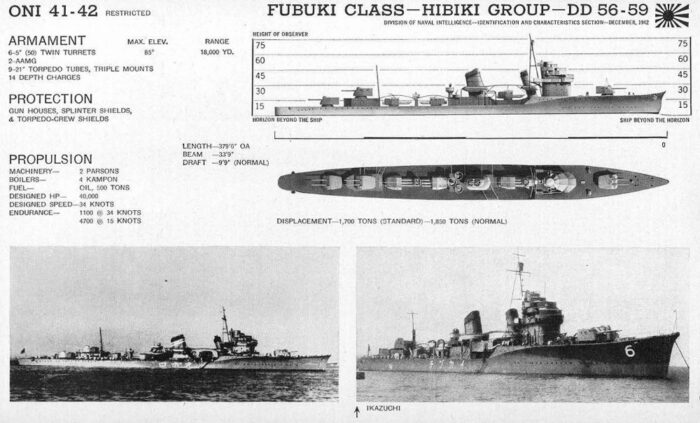
ONI file about the Akatsuki class
However, the Akatsuki class repeated also most design issues revealed in trial and early operations with the Fubuki class. This combination of heavy armament called by the naval staff, combined with a very tight hull displacement created top heavines and overall stability issues. After the Tomozuru Incident, these design practices were called into question. The four Akatsuki, like the Fubuki called for the addition of ballast to compensate, meaning their key dreamed fieature, a speed of 39 knots, was now out of reach.
Later the Fourth Fleet Incident, in which a typhoon damaging virtually every ship in this Fleet, called for a reinforcement of the longitudinal strength of the Akatsuki-class. To solve this issue and the earlier one, like the Fubukis, they were reconstructed from 1935 to 1937 with 40 tons of ballast added, the bridge reduced in size, as the smoke stacks. The number of torpedo reloads went from nine to three and only for the center launcher. Fewer shells were also stored for the main guns wheras the amount of fuel carried was augmented as a useful ballast, helping to restore these ships compromised center-of-gravity. The overall displacement rose to 2050 tons standard, 2400 tons full load and top speed in operations went down to 34 knots. 39 knots was never approached, even in trials.
The Akatsuki were built at the following yards:
Maizuru Naval Arsenal: Hibiki
Uraga docks: Ikazuchi
Fujinagata Shipyards: Inazuma
Sasebo Naval Arsenal: Akatsuki
They were named after natural events: Echo, Lightning, Dawn, Thunder.
Design of the class
Hull and general design

Schematics of the class. The small forward funnel and doubled bridge (later reduced) are a visual recoignition trademark for the class
The Akatsuki class hull repeated the Fubuki design in all points, including their shortcomings. But the new design remained striking altogether. They kept their S-shaped curved bow, the forecastle was long and narrow with a raised forward section, limited flare. They had of course raked funnels and masts and an increased seaworthiness in general. The raised forecastle raised compared to designs such as the Mutsuki reduced splashing in heavy seas and protected better the forward gun mount. The bridge was the same essentially as on the Fubuki, except the additional bridge on top with a full assortment of sight and fire control systems.
The splinter-proof torpedo launcher-turrets were also visual giveway.
Powerplant
The Akastuki as seen aboce diverged from the Fubukis by the adoption of three Kampon boilers instead of just one, but of a new model with higher burn rate and pressure, providinng the same power to their two Kampon geared turbines, connecting shaft with three bladed propellers. The performances figures remained about the same, as they were rated for 50,000 shp for a rated speed of 35 knots (65 km/h) but 39 knots (72 kph) expected originally, and a range of 5000 nautical miles (9,300 km) at 14 knots (26 km/h). The Kampon RO boilers were of a new type with greater superheating and pressure. They opened the door to foir of these in the future and regain 38-39 knots as originally planned but this was contradicted by stability issues which forced their weight up and degraded their operational top speed at 34 knots when fully loaded in the best conditions.
Armament
The Akatsuki-class destroyers like the other Fubuki groups, had a main battery of six Type 3 127 mm (5 inches) 50 caliber naval guns. The turret were not armoured but weather-proof and splinter-proof, gas-tight. Unlike Group I ships which had the Type A elevating to 40 degrees, Group II and III had true 70° elevation mounts, true dual-purpose guns and independent elevation. Ammunition came through hoists from underneath magazines in each gun turret, procuring a far greater rate of fire that the standard shielded guns that were manually loaded. They were, for all intents and purposes, midget cruiser turrets.
The Akatsuki class also had the same three triple 24-inch (610 mm) torpedo launchers with Type 8 torpedoes already seen on the Mutsuki-class. The 610mm became the new standard Japan adopted for its Navy with each tube having a reload on paper for a grand total of 18 torpedoes including the nine pre-loaded tubes.
Anti-aircraft defence was limited to two twin Type 93 13 mm AA Guns and it was gradually improved with 25 mm mounts (seelater).
In wartime Pacific service, at first theu received an extra pair of Type 93 heavy machine guns in front of the bridge on platform and then Type 96 25mm AA Guns.
12.7 cm/45 3rd Year Type naval gun
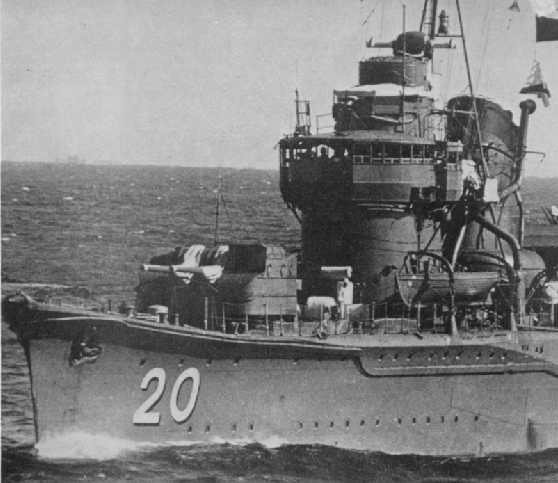
The 12.7 cm/50 Type 3 naval gun was a medium-caliber dual purpose naval gun of the Imperial Japanese Navy, standard weapon for Japanese destroyers rom 1928 and until 1944 (The Akizuki and Matsu classes were exceptions). These were taunted as true dual-purpose but this remains a nominal capability due to their bag propellant and hand ramming requiring a fixed elevation between 5–10° also translated into a rate of fire of 5–10 rounds per minute, training speed of only 6° per second. Somewhat useful in 1930 it was hoepeless against 1942 aircraft.
The Type 3 gun was of built-up construction with 3, then 2 layers, breech ring and breech bush (Welin interrupted screw breech) and still used powder bags, whereas the shell was fuzed manually on the loading tray before ramming by hand with the pusher-type shell hoist and manually insterted powder bags.
The Model A turrets of the Fubuki-class were just weather/splinter/gas proof 9–12 mm thick (0.35–0.47 in) and so fully enclosed. Later twin mounts had individual cradles to elevate separately and weighted c32 tonnes, traversing at 6° per second, elevated 6°-12° per second to +40°.
Model B mount elevated to 75° but shield reduced to 3.2 mm (0.13 in) thick and later reinforced again.
The Model C was adpted by the Shiratsuyu, Asashio, and Kagerō-class, with elevation down to 55°, depression to −7° and lighter
The Model D used by the Yūgumo-class/Shimakaze destroyers, retaining the same depression but elevation to 75°.
Mount weight: Type A/B 18.5 tonnes (18.2 long tons; 20.4 short tons)
Round: 23 kg (51 lb) HE, illumination, incendiary shrapnel (sankaidan) for AA use, flat-nosed ASW (1943). 1945: HE developed with added charge for 23,025 metres (25,180 yd).
Propellant: 7.7 kg (17 lb) 30 DC.
Muzzle velocity:
-Common Type 0 HE 23 kg (51 lb)/1.88 kg (4.1 lb): 910–915 m/s (2,986–3,002 ft/s)
-Common Type 1 HE 23 kg (51 lb)/1.88 kg (4.1 lb): 910–915 m/s (2,986–3,002 ft/s)
-Illumination 23 kg (51 lb): 750 m/s (2,500 ft/s)
-ASW 20.9 kg (46 lb)/4 kg (8.8 lb): 250 m/s (820 ft/s)
-HE 1945 LG type 27.9 kg (62 lb)/2.2 kg (4.9 lb): 910–915 m/s (2,986–3,002 ft/s)
⚙ specifications 12 cm/45 3rd Year |
|
| Weight | 4,205 kilograms (9,270 lb) |
| Barrel length | 6.483 metres (21.27 ft)/ barrel 6.265 metres (20.55 ft) |
| Elevation/Traverse | -7° +40° or more and 120°/120° |
| Loading system | Welin interrupted screw, Hydro-pneumatic recoil |
| Muzzle velocity | 910–915 m/s (2,986–3,002 ft/s) |
| Range | 18,400 metres (20,100 yd)/40° |
| Crew | 6 |
| Round | 20.3 kg (45 lb) 120 x 550 mm.R., sep. loading cased charge |
| Rate of Fire | 5–10 rpm |
Type 8 Torpedoes (1920)
The “8th Year Type” was a brand new 61 cm (24 in)-diameter torpedo made for surface ships and later further developed into the more advanced Type 90 torpedo and Type 93 Long Lance. It was designed in 1919 already but not for destroyers, and adopted in 1920 with the model 1. Later in 1925 appeared the model 2 with a larger warhead. The 8th Year Type the first-ever 61 cm (24 in) diameter torpedo in service anywhere, and rounded as a 610 mm (exactly 609 mm (24.0 in)) and initially deployed for the Mutsuki-class destroyers, Fubuki-class “special type” and several light cruisers when refitted such as the Nagara class. This caliber soon became standard.
The Hatsuharu-class and rebuilt heavy cruiser had these also and soon swapped onto the better Type 90 torpedo replacing them all. The latter was developed from 1928 aznd adopted in 1932, replacing the Type 8, but its seems the Mutsuki swapped directly to the Type 93.
The Type 8 used a four-cylinder Schwarzkopff radial engine with wet-heater mising kerosene and compressed air. The Type 90 torpedo had an new 2-cylinder double action engine and was capable of reaching 46 knots (85 km/h). The launching mechanism was improved as well. But the most important aspects was their adoption of a new “turret” protecting them, allowed the torpedo launcher tubes to be reloaded while in action, with the operating crew operated against shrapnel and elements (see later). They became mandatory on all destroyers. 18 torpedoes, so one reload for each tubes was initially planned, but reduced to just three for the amidship bank to reduce weight in 1936, so now 12 torpedoes.
⚙ specifications Type 8 Model 2 |
|
| Weight | 2,362 kg (5,207 lb) |
| Dimensions | 8.485 m (27 ft 10.1 in) x 60.9 cm (24.0 in) |
| Propulsion | Wet-heater |
| Range/speed setting | 10,000m/38 kts; 15,000 m/32 kts or 20,000 m/27 kts |
| Warhead | 763 lbs. (346 kg) Shimose |
| Guidance | Straight course |
Type 90 (1930)
This new type was adopted originally for heavy Cruisers and Fubuki destroyer classes only. Development started in 1928 and was completed in 1932, with introduction made in 1930 for tests and strict service adoption in 1933. It had a more powerful engine of the one used in the 53 cm Type 89. The starting point were the 46-knot (85 km/h) 21-inch (53 cm) Whitehead torpedoes and instead of a radial they used a new double-action two-cylinder engine. The compacity and extra power meant more speed but shorter range. Neither of the resulting 6th and 8th Year torpedoes were manufactured, but they led to the Type 90.
It’s thus not known if the Mutsuki were ever fitted with these or instead swapped directly to the Type 93.
⚙ specifications Type 90 |
|
| Weight | 2,605 kg (5,743 lbs.) |
| Dimensions | 8.485 m (27 ft 10 in) x 60.9 cm (24.0 in) |
| Propulsion | Kerosene-air wet-heater |
| Range/speed setting | 7,000 m/46 kts; 10,000 m/42 kts; 15,000 m/35 kts |
| Warhead | 827 lbs. (375 kg) Type 97 |
| Guidance | Straight course |
Type 93 (1933)
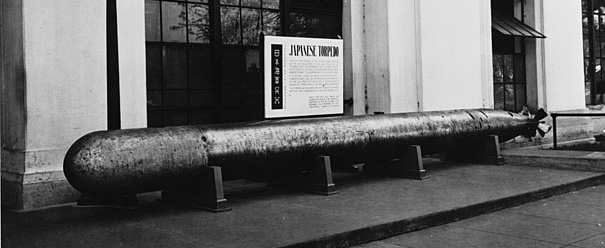
The Type 93 entered service in 1933 (model 1) and the ships were possibly rearmed in 1935-36 or never, it’s not strictly confirmed. The Type 90 could have been installed instead when available.
61 cm Type 93 torpedo found on the Mutsuki, Fubuki, Akatsuki classes, and all oxygen fuelled from the Hatsuhara and beyond. The Designer was Rear Admiral Kaneji Kishimoto, and Captain Toshihide Asakuma, and this started in 1928 (just as the last Mutsuki class ships were completed), then went on until 1932. The Type 93 became the nororious “secret weapon” unleashed by IJN destroyers and cruisers in WW2, which caused extebsive damage during the Solomons campaign expecially. The defective US Type 14 torpedo was in stark contrast with this. The Type 93 torpedo was dangerous to its user however but its effectiveness outweighed the risks anyway, claiming 23 Allied warships, 11 cruisers, 11 destroyers, and a fleet aircraft carrier and among these, 13 hits were fatal.
⚙ specifications Type 93 |
|
| Weight | 2.7 tonnes (6000 lb) |
| Dimensions | 9 metres (29 ft 6+5⁄16 in) x 610 mm (2 ft 1⁄64 in) |
| Propulsion | Oxygen-enriched air |
| Range/speed setting | 2,000 m (24,000 yd) at 48–50 kts or 40,400 m (44,200 yd) at 34–36 kts |
| Max speed | 96 km/h (52 kn) |
| Warhead | 490 kg (1080 lb) |
| Guidance | Straight course |
AA Defence
13.2 mm Type 93 heavy machine gun
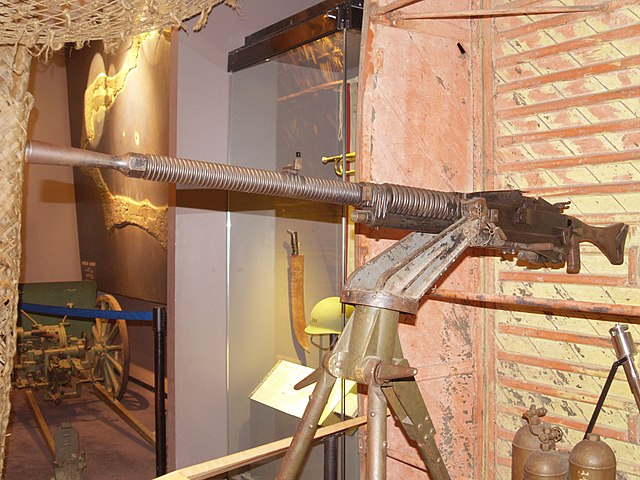
The Type 93 13 mm (0.55 inches) heavy machine gun (九三式十三粍機銃), Type Ho 13 mm AA machine cannon was a license-built version of the French Hotchkiss M1930 machine gun. It was widely used for heavy ground support and organic for AA defence, until gradually replaced when possible by the 25 mm Type 96. They were still in use, on twin mounts, on many IJN cruisers and destroyers before WW2 but gradually replaced when possible, notably by single 25 mm mounts due to unsufficient range and firepower.
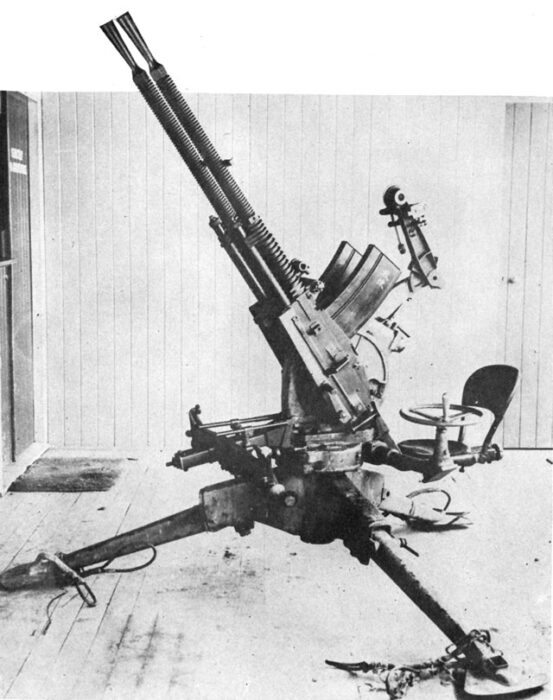
The common twin mount in 1941
Tech specifications Type 93 heavy machine gun |
|
| Barrel Lenght | 140 centimeters (55 in) total, 988 millimeters (38.9 in) barrel alone |
| Mass | 42 kilograms (93 lb) (empty) |
| Fully loaded | ? |
| Shell | 13.2×99mm Hotchkiss |
| Exact caliber | 13.2 mm |
| Barrel type | A tube with progressive RH parabolic twist, 9 grooves |
| Action | Gas-operated fully automatic |
| Elecation/Traverse | -15 / +85°, 360° traverse, manual |
| Rate of fire | 450 rounds/min Max |
| Muzzle velocity | ? |
| Effective range | 1,000 meters (3,300 ft) |
| Maximum firing range 45° | ? |
| Feed system | Classic box magazine holding 30 rounds |
| Sight | Spiderweb anti-aircraft iron sight |
25 mm Type 96

The type 96 25 mm AT/AA gun became the standard of the IJA and IJN, automatic cannon developed as variant of the French Hotchkiss 25 mm, dual-purpose and developed as AA on single, twin and triple mounts. Development worked on 1935. 25 mm Hotchkiss design evaluated and order placed for several mounts types for evaluation at Yokosuka Naval Arsenal. Led to the Type 94 and Type 95 and then the main model produced at Yokosuka Arsenal, the Type 96.
Elements made with castings and not forging for larger production, Rheinmetall supressor, new mounts designed.
Air-cooled gas operated with multiple rings (Hotchkiss patent).
Twin-mount in 1939, followed by triple mount in 1941 and single mount in 1943.
Issues of the designed revealed in combat:
Slow elevation and traverse, ineffective sights, excessive vibration, limited magazine cap., blinding Flashes.
The 1944 single mount needed a single operator and a loader but had a better spiderweb sight.
Tech specifications 25 mm Type 96 |
|
| Barrel Lenght | 1.5 m (4 ft 11 in) L/60 |
| Barrel weights: Single | 785 kg (1,731 lb) |
| Barrel weights: Twin | 1,100 kg (2,400 lb) |
| Barrel weights: Triple | 1,800 kg (4,000 lb) |
| Crew: | 3, 7 and 9 respectively |
| Shell | 25×163mm |
| Exact caliber | 25 mm (0.98 in) |
| Action | Gas operated |
| Elevation/Traverse | -10°/+85° – 360°, manual |
| Rate of fire | 200–260 rpm (cyclic) |
| Muzzle velocity | 820 m/s (2,700 ft/s) |
| Effective range | 6.8 km (4.2 mi) at 45° with HE shell |
| Maximum firing range 85° | 3 km (9,800 ft) effective, 5.5 km (18,000 ft) max. |
| Feed system | 15-round box magazine |
| Production | 33,000 all variants 1935-45 |
Depth Charges
The Akatsuki-class had two Type 81 depth charge launchers at the stern, with a total of 18 depth charges. This was augmented in wartime.
Standard Type 95, 30.5″ by 17.7″ (77.5cm by 45cm). 220 lb (100 kg) charge, Type 88 explosive (ammonium perchlorate and ferrosilicate). Fuse using a water inlet. 100 feet (30m) and 200 feet (60m) settings (after the revelations of a US Congressman).
Later increased to 324 lb (147kg), Type 97 explosive (70% TNA/30% HNDA), 300 foot (90m) setting.
-1944 Type 2: 230 lbs (105kg) Type 97 explosive settings 98, 197, 292, 390, 480 feet (30m, 60m, 89m, 120m, and 145m).
-1945 Type 2: 357 lbs (162kg) explosives.
Mines
20 mines on rails, no precision given. Can be any of the models here.
The ships were also given an optional mechanical minesweeping gear.
Sensors (WW2)
xxx received a Type 22 radar in November 1943, the remaining seven as well from 1944. Survivors received the Type 13 radar.
Type 22 radar
The early Type 22 General Purpose Radar looks like characteristically like a 2910 lb (1320 kg) drum topped with a twin cornet amplificators, mounted mid-way top the mast.
Specs:
Wavelength 10 cm, pwd 10 microsecond, PRF 2500 Hz, scan rate 5 rpm, PP 2 kW
Range: 20 nautical miles (35 km) aircraft group, 10 nm (17 km) single, 13 nm(24 km) battleship.
Subject to land clutter. Horn and A scope display, accuracy 220 yards (200m)/3 degrees res. 1600 yards (1500 m)/40 degrees
300 sets produced installed on destroyers from the summer 1942. Generalized in 1944.
Type 13 radar
Vertical 240 lb(110 kg) bedframe antenna, developed 1941, introduced mi-1943, with vertical dipole transmitter and Yagi mattress receiver. 1000 sets produced. Air defense, range 100 km (group), and single aicraft 50km.
Specs:
Wavelength 200 cm, pw 10 ms, PRF 500 Hz PP 10 kW
Range: 30-60 nautical miles (50-100 km)

Author’s profile and poster
⚙ Akatsuki class specifications |
|
| Displacement | 1,750 long tons (1,780 t) standard 2,050 long tons (2,080 t) FL |
| Dimensions | 118.41 x 10.4 x 3.2m (388.5 x 34 ft 1 in x 10 ft 6 in) |
| Propulsion | 2 shaft Kampon GST, 4 boilers 50,000 hp (37,000 kW) |
| Speed | 38 knots (44 mph; 70 km/h) |
| Range | 5,000 nmi (9,300 km) at 14 knots (26 km/h) |
| Armament | 3×2 127 mm/50, 2× Type 96 13 mm HMGs, 3×3 TTs 610 mm (18), 18 DCs |
| Sensors | Type 93 sonar, Type 2/3 radars (1944) |
| Crew | 219 |
Note: These are the exact same specs as the Fubuki Group I and II.
Gallery (all colorized by Irootoko Jr.)
Career of Group III
 IJN Akatsuki
IJN Akatsuki
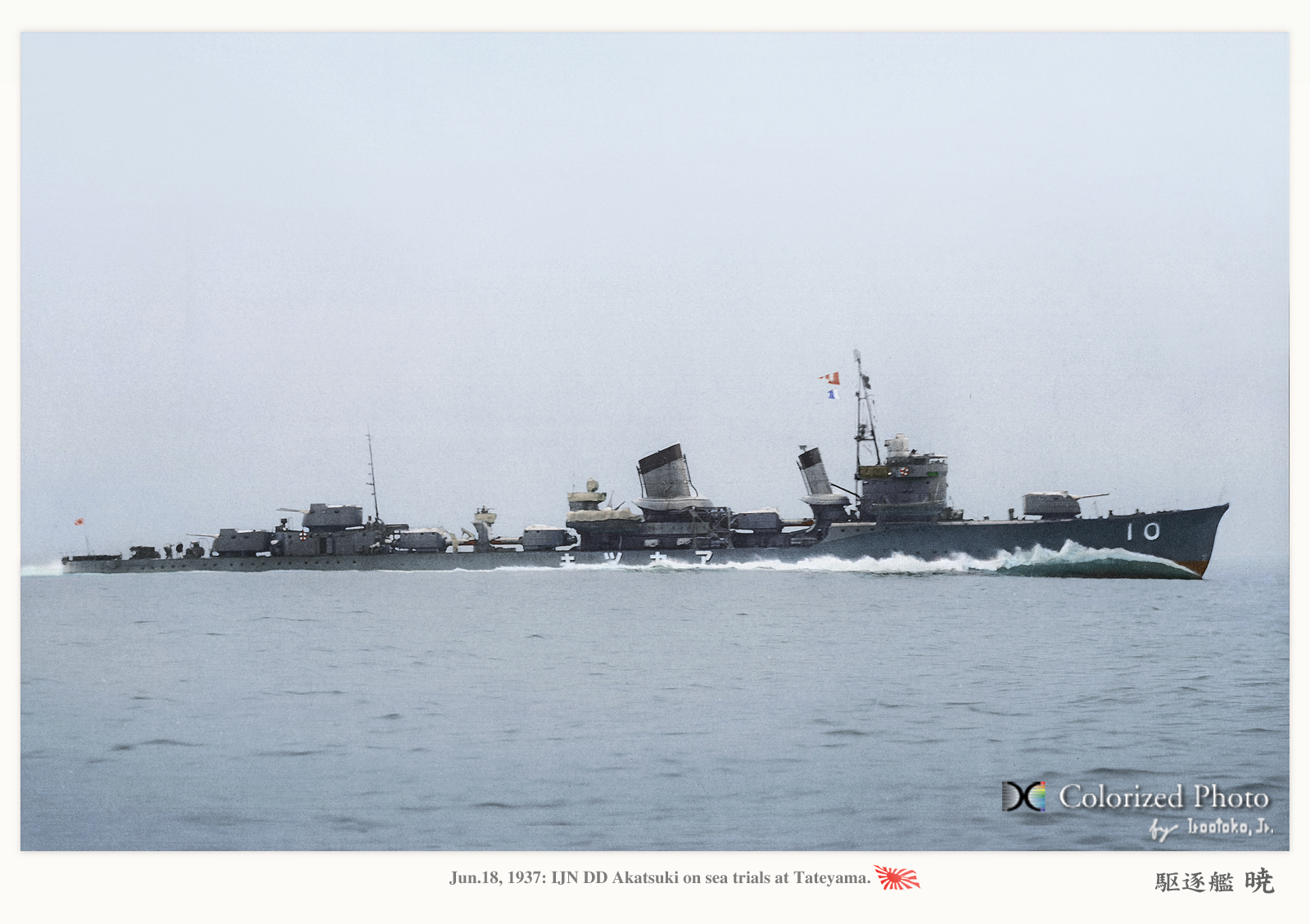
On completion, Akatsuki (Dawn) was assigned to Destroyer Division 6 with her sisters, in the 1st Fleet. She ws part of maneuvers off Ise Bay on 1 August 1935 when colliding I-6, the latter having her periscopes bent.
She was modified in 1935-37, with ballasts, top weight reduction and bracing. She took part after this to the Second Sino-Japanese War operations from July 1937.
In December 1941 at the time of Pearl Harbo ahd remained with her sisters in DesDiv 1, assigned to Desron 1, 1st Fleet, deployed from Mako Guard District. She sailed in formation to cover landing operations in Malaya and the Philippines, then the Netherlands East Indies, invasion of western Java. On 17 March 1942 she detected USS Permit after an attack and depht charged her, but she managed to escape.
She was back at Yokosuka Naval Arsenal for maintenance in March 1942 and was reassigned with her unit for northern Pacific operations, deployed from the Ōminato Guard District (Hokkaido) to support Admiral Boshiro Hosogaya’s Northern Force, taking part in the Aleutians campaign, Kiska and Attu in this summer from June-July. She towed her damaged sister IJN Hibiki from Kiska to Paramushiro (Chishima Jima) for provisional repairs. She remained with the northern patrols Chishima-Aleutian in August and returned for maintenance at Yokosuka before being reassigned to escort IJN Zuihō and Unyō to Truk, before joining operations in the Solomon Islands before returning to Kure.

Akatsuki off Kiska, 1943
From October 1942 she was back in the Solomons to take part in a serie of “Tokyo Express” runs. On the 25th with Ikazuchi, and Shiratsuyu she performed a daring daylight raid in “Ironbottom Sound” for a hunter-killer action, badly damaging the fast minesweeper USS Zane and sinking the fleet tug USS Seminole, patrol craft YP-284, before being fired at by US Marine coastal artillery. Akatsuki received a hit close to her No.3 gun turret (4 crewmen killed).
Three weeks later she returned to “Ironbottom Sound” with the bombardment force centered around Hiei and Kirishima. On the night of 12–13 November she was part in the Naval Battle of Guadalcanal on the right flank of the Kongo class battleships. She is often credited by illuminating and torpedoing USS Atlanta but surviving sailor Michiharu Shinya unequivocally stated that she was overwhelmed by gunfire before being capable of launching any torpedoes. She was indeed obliterated by close quarter quick gunfire, sinking near Savo Island. All but 18 survived, later captured by U.S. forces, POW at the Featherston camp in New Zealand. On 15 December 1942, Akatsuki was stricken.
 IJN Hibiki
IJN Hibiki
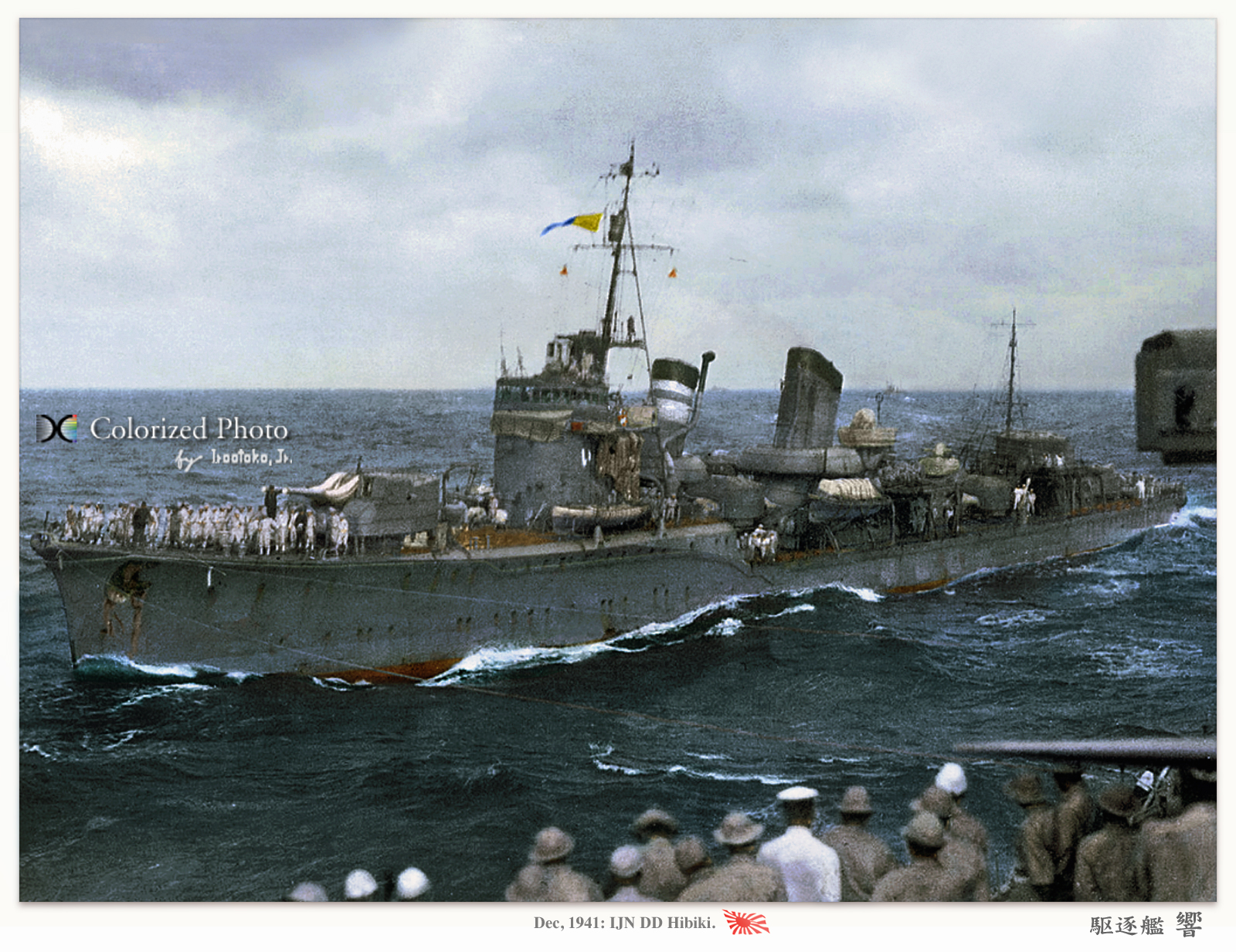
Hibiki (“Echo”) was laid down on 21 February 1930, launched on 16 June 1932 and commissioned on 31 March 1933. With her sister ships she formed Destroyer Division 6. Until 1941 she served like her sisters in China. From 29 November to 2 December 1941 she sailed from Terashima Strait to Mako in the Pescadores when DesDiv 6 was assigned to Desron 1, 1st Fleet. At Mako Guard District they provided cover for Admiral Nobutake Kondō’s Southern Force to escort troopships for landing in Malaya and the Philippines, and support operations until March 1942.
After refit at Yokosuka in April 1942 like her sister she departed northwards for the Ōminato Guard District and then to the Aleutians (see above) to support the invasion of Kiska in May–June 1942. On 12 June she was damaged by PBY Catalina flying boats, forced back to Ōminato for repairs at Yokosuka, until October.

From November until late April 1943, she escorted the carriers Unyō and Taiyō in missions to Truk, except in January 1943 when she was dry docked at Yokosuka for maintenance. From May 1943 she was back in northern waters, Hokkaidō-Chishima islands and later she assisted in the evacuation of the Aleutians until August.
After maintenance at Yokosuka in September she was ordered to Shanghai, escorting a troop convoy to Truk and Rabaul. Until late November, she escorted tanker convoys between Balikpapan, Singapore and Truk. She performed also high speed transprot runs between Truk, Ponape and the Carolines. She rescued survivors from Terukawa Maru on 21 December. From December 1943 to April 1944, she escorted the aircraft carriers Hiyō, Ryūhō, and Chiyoda between the western Pacific and Netherlands East Indies.
She was in maintenance at Kure in April 1944, receiving extra AA guns and radars, and from May to June 1944, she returned to tanker convoys. On 14 May, she rescued 12 from her sister Inazuma. She was present at the Battle of the Philippine Sea, but escorting the 1st Supply Force, being damaged by USN aviation strafing attacks (2 killed). In August, she escorted two convoys from Moji to Takao and Okinawa and by September, headed for Manila, when she was torpedoed by USS Hake, the detonation almost cutting her bow. She was able to returned to Yokosuka for long repairs and on 25 January 1945, she was reassigned to DesDiv 7, 2nd Fleet, in home waters. Next she ended in the 1st Escort Fleet in May, Kure Naval District as guard ship until V-Day.
Only survivor of her class she was demilitarized, used as a repatriation vessel, stricken on 5 October 1945 but placed on a waiting list to decide her fate.
The allied war reparation commission attributed her on 5 April 1947 to the Soviet Union. She was renamed Nakhodka and then “Verniy” (“Faithful”), rearmed with Soviet guns, three twin 130 mm guns, seven 25 mm guns, six 12.7 mm DsHk heavy machine guns, six soviet 533 mm torpedo tubes and staying with the Soviet Pacific Fleet in Vladivostok from 7 July 1947. On 5 July 1948 she was renamed Dekabrist (“Decembrist”) and was mothballed to be disarmed and modernized, and used eventually as floating barracks until stricken on 20 February 1953 and discarded as target ship in the 1970s, sunk close to Karamzina Island under 27 meters, explored by local diving tours.
 IJN Ikazuchi
IJN Ikazuchi
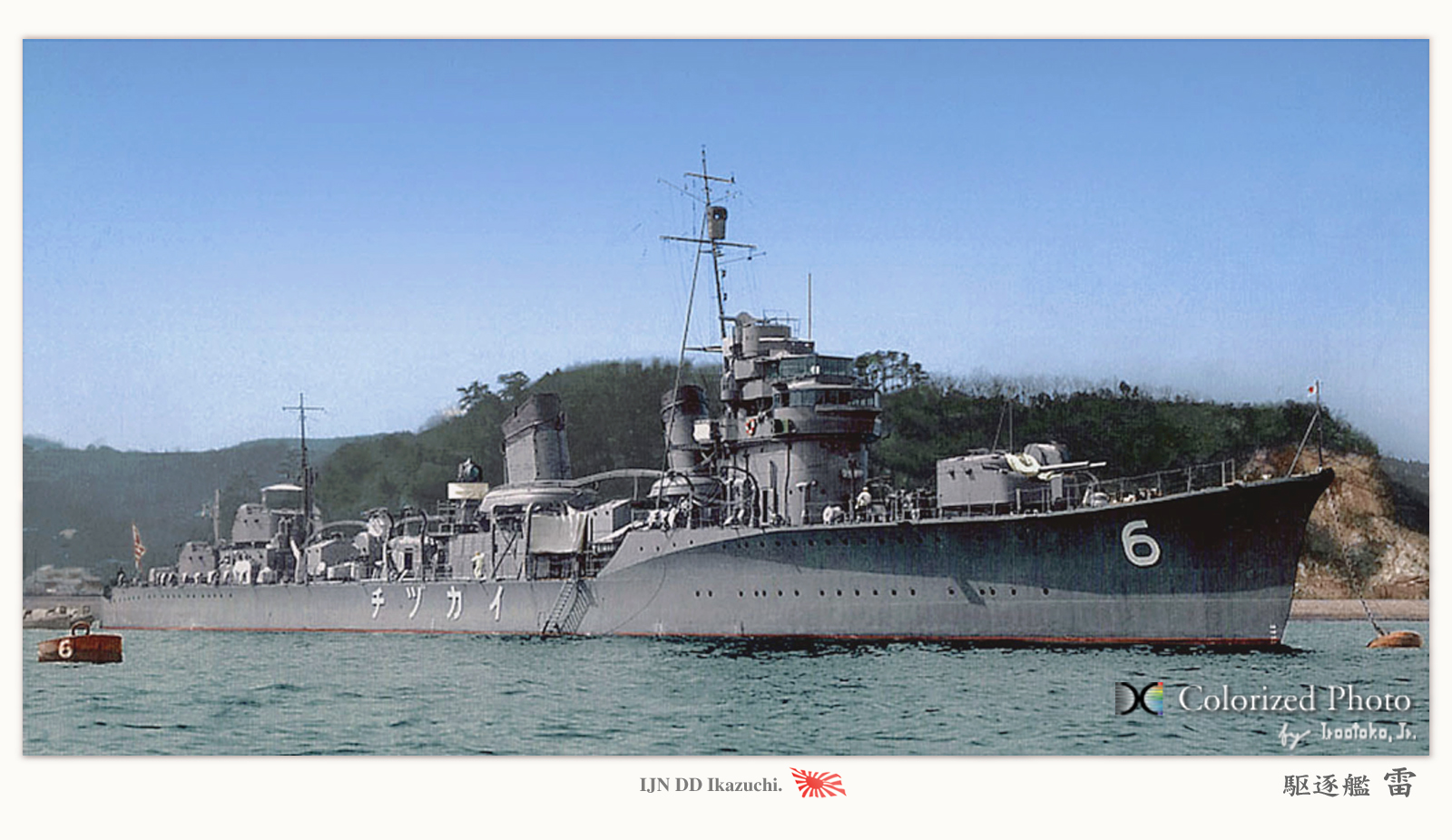
Ikazuchi (thunder) was laid down on 7 March 1930, launched on 22 October 1931 and Commissioned on 15 August 1932. On completion, she was assigned to DesDiv 6, 1st Fleet with her sisters, taking part in manoeuvers, reinforced and modified 1936-37, and taking part in the Second Sino-Japanese War operations until 1941.
Like her sisters in December she was part of Desron 1, 1st Fleet, Mako Guard District and deployed for the Invasion of Hong Kong. She escorted the cruiser Isuzu in sinking the Insect class riverine gunboats HMS Cicada and HMS Robin as well as taking Victoria Harbour. In early 1942 she left Hong Kong to Davao in the Philippines, and later brought cover fire during the landings and Battle of Ambon, as well as the Battle of Timor, Netherlands East Indies.
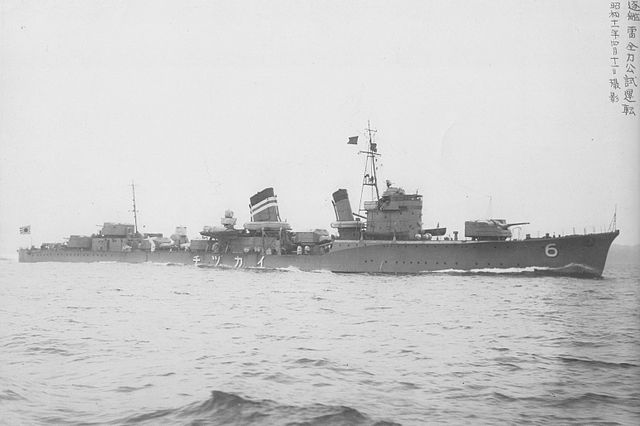
On 2 March 1942, Ikazuchi rescued 400 survivors from HMS Exeter and HMS Encounter, both sunk at the Second Battle of the Java Sea, adrift for 20 hours in rafts or life jackets. This humanitarian decision by Lieutenant Commander Shunsaku Kudō risked submarine attack, later the subject of a book and TV programme. She was deployed from Ōminato Guard District like her sisters for the Aleutians campaign, Kiska and Attu in June-July, towing Kasumi from Kiska to Shimushu (Chishima) and remained in northern patrols, Chishima-Aleutian islands in August. In September she escorted Zuihō and Unyō to Truk and then the Solomon Islands and back to Kure for overhaul.
From October, she was part of a serie of “Tokyo Express” runs in the Solomons and on 25 October 1942 with her sister Akatsuki, and Shiratsuyu she took part in a daylight raid off Guadalcanal (see above) sinking and damlaging US ships but repelled by coastal batteries and light damage from strafing attacks (4 crewmen killed). She took part in the first night action of the Naval Battle of Guadalcanal, 13 November 1942. Like Akatsuki she was on the right flank of Hiei and Kirishima and engaged USS Atlanta, but was hit at her forward gun mount, in fire. She lost 21 crewmen, 20 more injured, and needed long repairs at Truk and at Yokosuka until late February 1943.
She returned to the Aleutians, this time present at the Battle of the Komandorski Islands on 26 March, but escorting vessels and out of the action. On 30 March, she collided with Wakaba. Next she joined Desron 11 (1st Fleet) from 1 April 1943 and after an overhaul at Yokosuka, she was sent to Truk, escorting convoys from Truk to the home islands until mid-April 1944.
Under her new CO Commander Ikunaga Kunio from 13 April 1944, she escortd the transports Sanyō Maru to Woleai when torpedoed and sunk by USS Harder, c200 nautical miles (370 km) SSW of Guam, no survivors. She was officially stricken on 10 June 1944.
 IJN Inazuma
IJN Inazuma
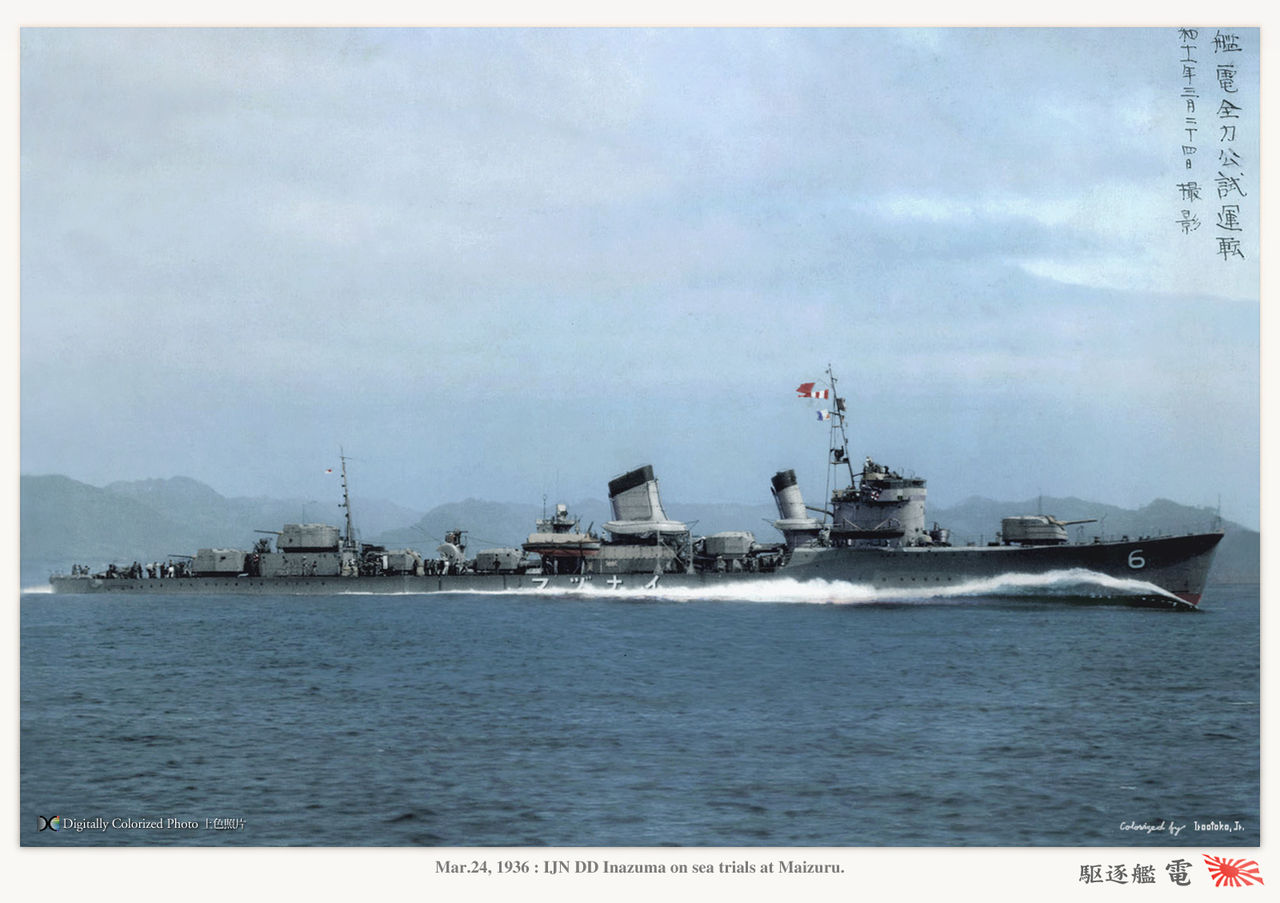
IJN Inazuma (Lightning) was laid down on 7 March 1930, launched on 25 February 1932 and commissioned on 15 November 1932. On 9 June 1934 she collided with Miyuki in exercizes on 29 June off Cheju Island. Miyuki sank and she lost her bow, being towed to Sasebo by Nachi for extensive repairs.
She returned in DesDiv 6, First Fleet for operations in China from 1937 to 1941.
Like her sisters in December she was deployed from Mako Guard District, taking part in the Invasion of Hong Kong and with Isuzu, sank HMS Cicala and HMS Robin. In early 1942, she sailed for Davao, covering the landings of Manado, Netherlands East Indies and on 20 January, she collided with the transport Sendai Maru at Davao. She was provisionally repaired by the specialized ship Akashi and proceed to Mako for final repairs.
On 1 March she was back in operations, taking part in the Second Battle of the Java Sea, assisted sinking HMS Encounter and HMS Exeter with two torpedoes. She took part in a massive rescue of 400 survivors from Exeter and two days later of the destroyer USS Pope which abandoned ship 60 hour prior. Next she took part in March 1942 operations in the Philippines before heading to Yokosuka for repairs, overhaul and maintenance in April.
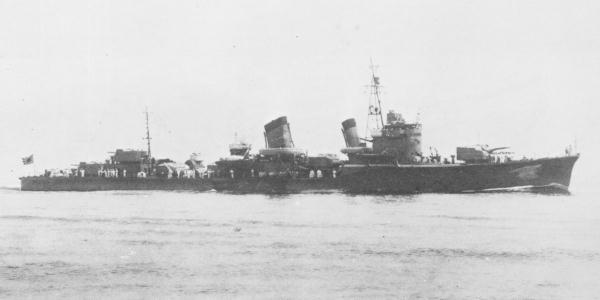
Next she was sent to Ōminato Guard District to take part in the Aleutians campaign, patrolling around Kiska and Attu in June-July, rescuing 36 from the DD IJN Nenohi and remained in northern patrols at Chishima and to the Aleutian into August. Next she was at the Kure Naval District for training in the Inland Sea with the carriers Junyō and Hiyō and escorting them to Truk and then to the northern Solomon Islands.
She was present at the Second Naval Battle of Guadalcanal, claiming sinking an American cruiser, which was never confirmed and assisted sinking USS Benham, USS Walke and USS Preston, damaging USS Gwin.
Based in Truk afterwards she started a serie of “Tokyo Express” runs in the Solomons but by mid-January 1943, she was sent back for maintenance at Kure, before returning south, escorting Zuikaku, Mutsu and Suzuya. After repairs in February she was back north to Ōminato but was escorting transports for evacuations during the Battle of the Komandorski Islands in March. From April to the fall of 1943 she escorted convoys between Yokosuka and Truk.
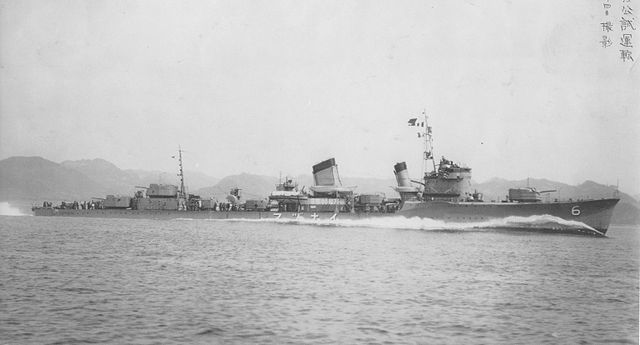
In February 1944 she was sent back to the Combined Fleet and in March escorted IJN Chiyoda for missions from Palau. While escorting a tanker convoy from Manila towards Balikpapan, underway in the Celebes Sea near Tawitawi on 14 May 1944, she was hit by at least two torpedoes from USS Bonefish. 161 went down with her, including commander Tomura Kiyoshi, CO Lt. Tokiwa Teizo, torpedo officer Lt. Furutani Tomo’o and Hibiki rescued 121-125 survivors. She was stricken on 10 June 1944.
Read More/Src
Books
Evans, David (1979). Kaigun: Strategy, Tactics, and Technology in the Imperial Japanese Navy, 1887-1941.
Brown, David (1990). Warship Losses of World War Two. Naval Institute Press.
Howarth, Stephen (1983). The Fighting Ships of the Rising Sun: The Drama of the Imperial Japanese Navy, 1895–1945. Atheneum.
Jentsura, Hansgeorg (1976). Warships of the Imperial Japanese Navy, 1869–1945. US Naval Institute Press.
Morison, Samuel Eliot (1958). The Struggle for Guadalcanal, August 1942 – February 1943, vol. 5 of History of United States Naval Operations in World War II. Boston: Little, Brown and Company.
Nelson, Andrew N. (1967). Japanese–English Character Dictionary. Tuttle.
Watts, Anthony J (1967). Japanese Warships of World War II. Doubleday.
Whitley, M J (2000). Destroyers of World War Two: An International Encyclopedia. London: Arms and Armour Press.
Evans, David (1979). Kaigun: Strategy, Tactics, and Technology in the Imperial Japanese Navy, 1887–1941.
Brown, David (1990). Warship Losses of World War Two. Naval Institute Press.
Howarth, Stephen (1983). The Fighting Ships of the Rising Sun: The Drama of the Imperial Japanese Navy, 1895–1945.
Jentsura, Hansgeorg (1976). Warships of the Imperial Japanese Navy, 1869–1945. US Naval Institute Press.
Morison, Samuel Eliot (1958). The Struggle for Guadalcanal, August 1942 – February 1943, vol. 5 of History of United States Naval Operations in World War II. Boston: Little, Brown and Company.
Nelson, Andrew N. (1967). Japanese–English Character Dictionary. Tuttle.
Watts, Anthony J (1967). Japanese Warships of World War II. Doubleday.
Whitley, M J (2000). Destroyers of World War Two: An International Encyclopedia. London: Arms and Armour Press.
Links
on globalsecurity.org
on combinedfleet.com
archive.ph homepage2.nifty.com/nishidah
The Pacific war: Akatsuki class
on en.wikipedia.org/
combinedfleet TROM hibiki
http://www.combinedfleet.com/inazum_t.htm
https://www.globalsecurity.org/military/world/japan/akatsuki-dd.htm
https://forum.axishistory.com/viewtopic.php?t=225701
https://archive.ph/20121210123710/http://homepage2.nifty.com/nishidah/e/stc0424.htm
https://web.archive.org/web/20140103040520/http://www.history.navy.mil/photos/sh-fornv/japan/japsh-a/akatsuk3.htm
en.wikipedia.org/ Japanese_61_cm_torpedo
pwencycl.kgbudge.com Type 13 air search radar
pwencycl.kgbudge.com Type 22 general purpose radar
blog.livedoor.jp Fubiki Gp III colorized photos
on commons.wikimedia.org
en.wikipedia.org/ Japanese_61_cm_torpedo
combinedfleet.com/akatsu_c.htm
Model Kits
Japanese Navy Destroyer Akatsuki Water Line Series Tamiya No. 31406 1:700
IJN Destroyer Hibiki 1945 Pit-Road No. SPW77 1:700
More on scalemates



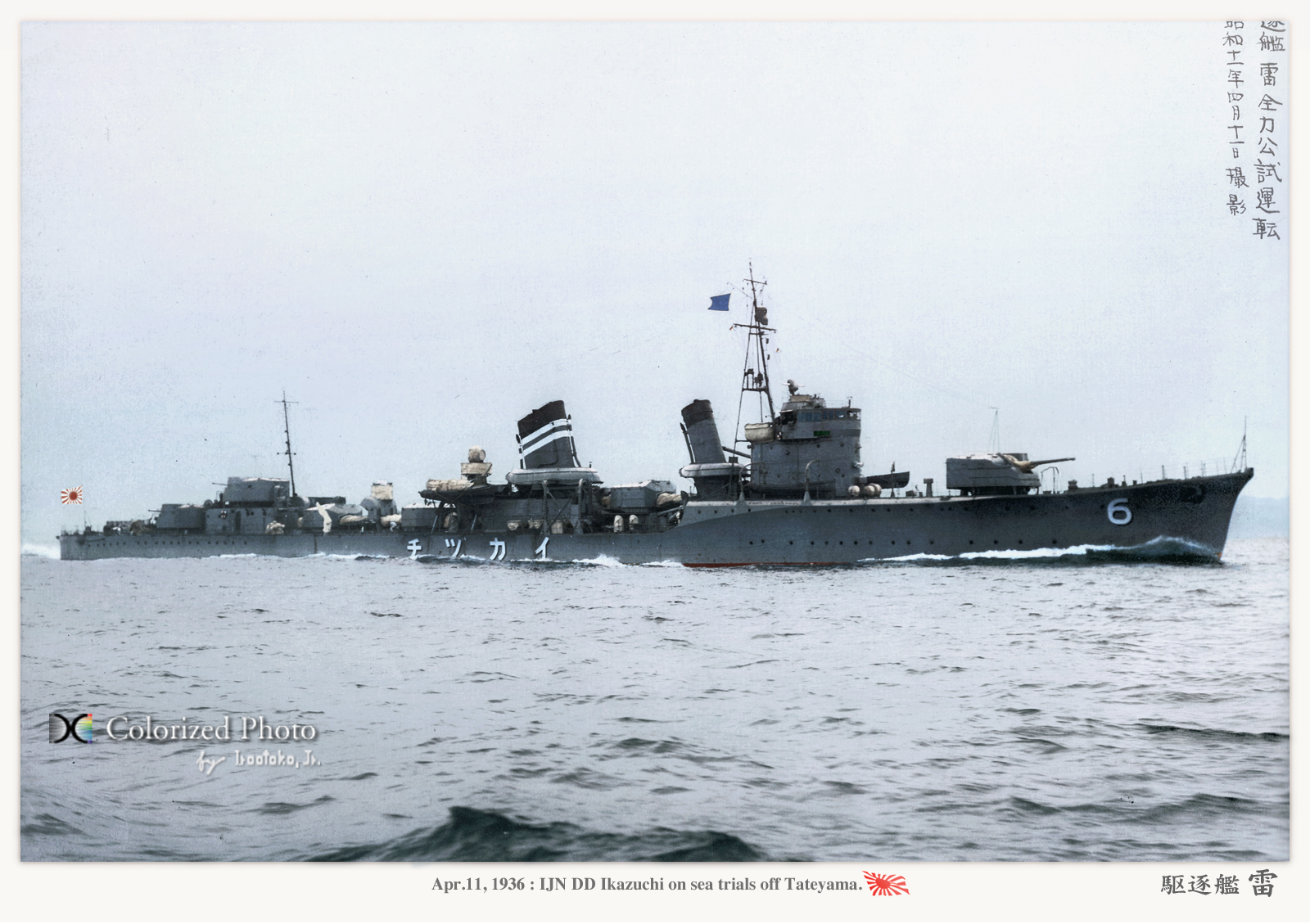
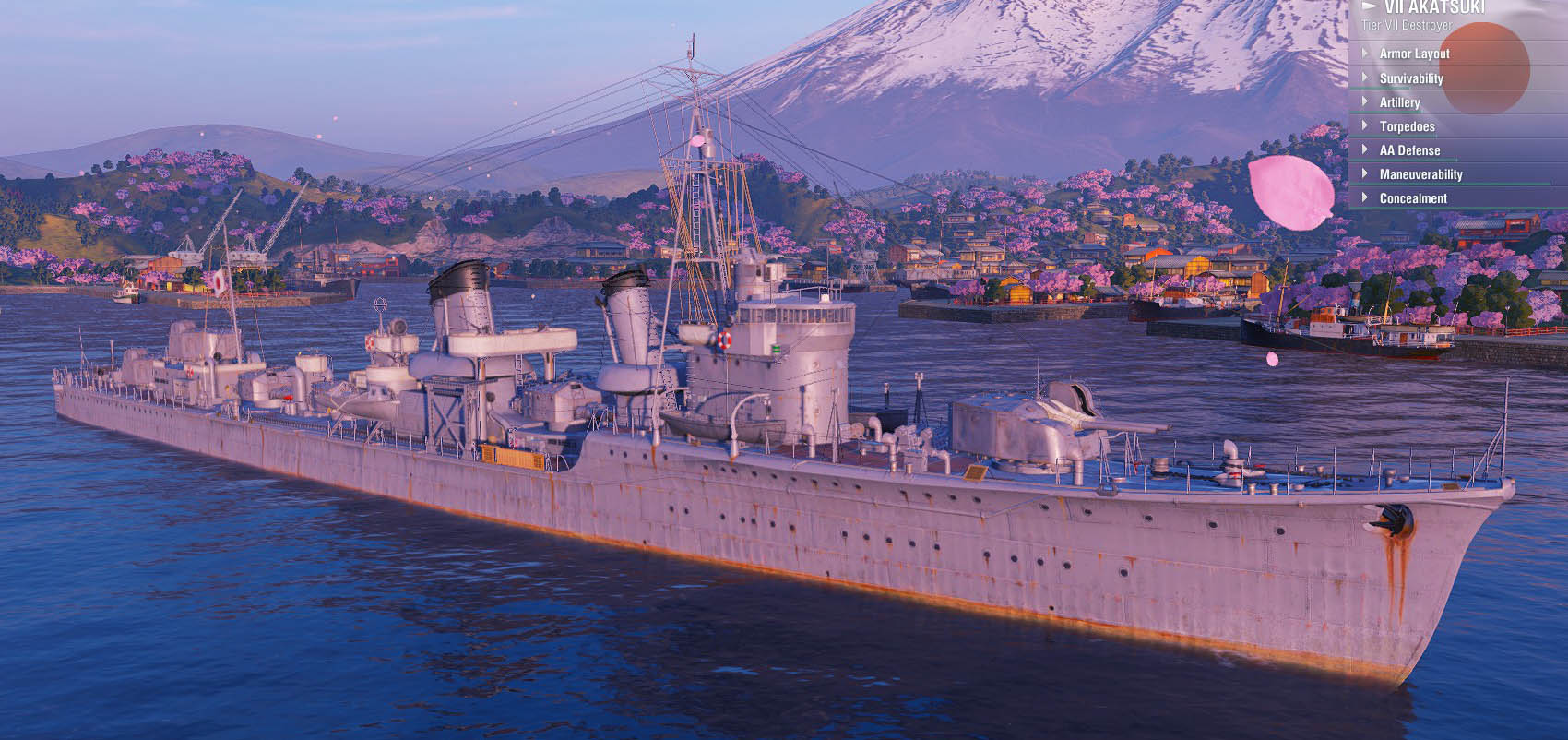
 Latest Facebook Entry -
Latest Facebook Entry -  X(Tweeter) Naval Encyclopedia's deck archive
X(Tweeter) Naval Encyclopedia's deck archive Instagram (@navalencyc)
Instagram (@navalencyc)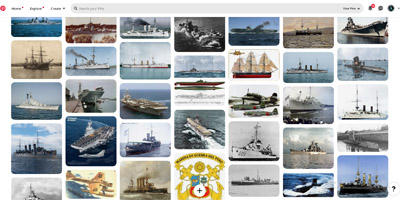

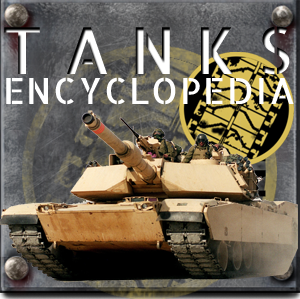
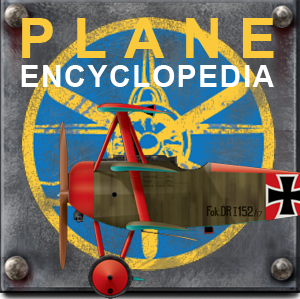
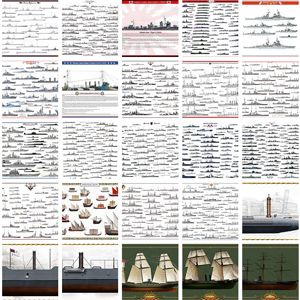
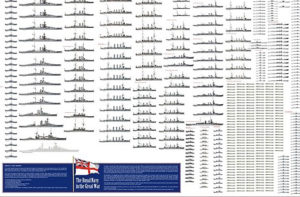
 French Navy
French Navy Royal Navy
Royal Navy Russian Navy
Russian Navy Armada Espanola
Armada Espanola Austrian Navy
Austrian Navy K.u.K. Kriegsmarine
K.u.K. Kriegsmarine Dansk Marine
Dansk Marine Nautiko Hellenon
Nautiko Hellenon Koninklije Marine 1870
Koninklije Marine 1870 Marinha do Brasil
Marinha do Brasil Osmanlı Donanması
Osmanlı Donanması Marina Do Peru
Marina Do Peru Marinha do Portugal
Marinha do Portugal Regia Marina 1870
Regia Marina 1870 Nihhon Kaigun 1870
Nihhon Kaigun 1870 Preußische Marine 1870
Preußische Marine 1870 Russkiy Flot 1870
Russkiy Flot 1870 Svenska marinen
Svenska marinen Søværnet
Søværnet Union Navy
Union Navy Confederate Navy
Confederate Navy Armada de Argentina
Armada de Argentina Imperial Chinese Navy
Imperial Chinese Navy Marinha do Portugal
Marinha do Portugal Mexico
Mexico Kaiserliche Marine
Kaiserliche Marine 1898 US Navy
1898 US Navy Sovietskiy Flot
Sovietskiy Flot Royal Canadian Navy
Royal Canadian Navy Royal Australian Navy
Royal Australian Navy RNZN Fleet
RNZN Fleet Chinese Navy 1937
Chinese Navy 1937 Kriegsmarine
Kriegsmarine Chilean Navy
Chilean Navy Danish Navy
Danish Navy Finnish Navy
Finnish Navy Hellenic Navy
Hellenic Navy Polish Navy
Polish Navy Romanian Navy
Romanian Navy Turkish Navy
Turkish Navy Royal Yugoslav Navy
Royal Yugoslav Navy Royal Thai Navy
Royal Thai Navy Minor Navies
Minor Navies Albania
Albania Austria
Austria Belgium
Belgium Columbia
Columbia Costa Rica
Costa Rica Cuba
Cuba Czechoslovakia
Czechoslovakia Dominican Republic
Dominican Republic Haiti
Haiti Hungary
Hungary Honduras
Honduras Estonia
Estonia Iceland
Iceland Eire
Eire Equador
Equador Iran
Iran Iraq
Iraq Latvia
Latvia Liberia
Liberia Lithuania
Lithuania Mandchukuo
Mandchukuo Morocco
Morocco Nicaragua
Nicaragua Persia
Persia San Salvador
San Salvador Sarawak
Sarawak Uruguay
Uruguay Venezuela
Venezuela Zanzibar
Zanzibar Warsaw Pact Navies
Warsaw Pact Navies Bulgaria
Bulgaria Hungary
Hungary

 Bundesmarine
Bundesmarine Dutch Navy
Dutch Navy Hellenic Navy
Hellenic Navy Marina Militare
Marina Militare Yugoslav Navy
Yugoslav Navy Chinese Navy
Chinese Navy Indian Navy
Indian Navy Indonesian Navy
Indonesian Navy JMSDF
JMSDF North Korean Navy
North Korean Navy Pakistani Navy
Pakistani Navy Philippines Navy
Philippines Navy ROKN
ROKN Rep. of Singapore Navy
Rep. of Singapore Navy Taiwanese Navy
Taiwanese Navy IDF Navy
IDF Navy Saudi Navy
Saudi Navy Royal New Zealand Navy
Royal New Zealand Navy Egyptian Navy
Egyptian Navy South African Navy
South African Navy






























 Ukrainian Navy
Ukrainian Navy dbodesign
dbodesign